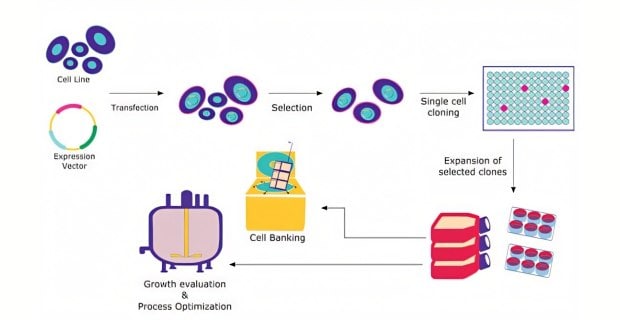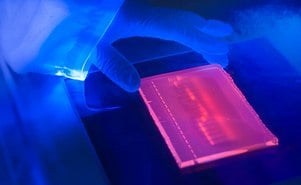Cloning & Expression

Recombinant Protein Expression in Mammalian Cells
Cloning and gene expression technologies are used by researchers in diverse fields to investigate a wide range of biological questions, including understanding gene function, molecular pathway analysis, embryonic development, disease research, and bioprocessing of biologics and therapeutics to name a few. Once the gene or genetic sequence is identified, researchers must choose the best molecular cloning strategy and cell-based protein expression system based on the specific application need. For additional information on gene expression using CRISPR technology, or gene silencing using RNAi reagents, please visit our gene expression and gene silencing page.
Featured Categories
Our extensive portfolio of high-purity biological buffers in various formulation and packaging formats provide superior solution stability and pH control throughout your bioprocess workflow applications.
We offer a wide range of agarose products with various gel strengths, melting temperatures, gelling temperatures, and electroendosmosis (EEO) levels to support your research applications.
Protein Expression Vectors
Plasmids, or protein expression vectors, are circular pieces of DNA that contain numerous functional elements for cloning and expressing the protein of interest. The selection of the appropriate expression vector is partially determined by the type of protein, the organism that will express the protein, and the specific application and scientific questions the researcher aims to address. The wide variety of expression vectors available allows researchers to choose which cloning, clone selection, and protein expression elements are best for their study. Once the gene sequence of interest and the expression vector is selected, researchers commonly use nucleases to precisely cut the vector at specific sites to allow the genetic sequence of interest to be cloned in-frame and ultimately expressed in a host organism. Importantly, researchers will commonly use chemically competent cells and bacterial transformation to host the recombinant DNA plasmids as they are stable when stored frozen at -70 °C.
How to Transfect Cells
Cell transfection refers to the process of introducing DNA or RNA, or proteins into eukaryotic cells. A variety of physical, chemical, and biological technologies are available to researchers to accomplish this part of the protein expression workflow. Physical methods, such as electroporation, or chemical methods, including calcium phosphate (CaPi), polyethylenimine (PEI), and lipofection reagents are all commonly used by researchers. Viral transduction systems, including lentiviral, oncoretroviral, and adenoviral are also available to scientists. However, the use of viral delivery methods often requires additional containment and monitoring for biosafety reasons.
Protein Expression Systems
Various organisms are used by researchers to express their protein of interest. Bacteria are commonly used by researchers as they efficiently uptake expression vectors, have fast doubling times, and can produce high quantities of recombinant protein under optimal conditions. However, as bacteria are prokaryotic organisms, they are not able to provide protein post-translational modifications that some proteins require. Eukaryotic cells, including yeast and mammalian cell lines, facilitate protein post-translational modification(s) and are also commonly used by researchers. The choice of the best cell line for recombinant protein expression and the protein expression strategy is highly dependent on the specific application needs and questions the scientist aims to address.
Visit our document search for data sheets, certificates and technical documentation.
Related Articles
- The term “Restriction enzyme” originated from the studies of Enterobacteria phage λ (lambda phage) in the laboratories of Werner Arber and Matthew Meselson.
- This cloning protocol includes selecting the cloning system and plasmid vector, plasmid restriction digestion, fragment restriction digestion, gel excision, dephosphorylating DNA and more.
- Transfection introduces genetic material into cells, aiding research in gene expression and cell biology.
- The 3xFLAG system enhances fusion protein detection, offering improved sensitivity over traditional methods.
- For best results, ligation reactions must be heat inactivated at 70º C for 15 minutes before transformation. Alternately, the reactions may be purified.
- See All (25)
Related Protocols
- Restriction enzyme collection has been optimized for digestion using five unique buffers.
- This page describes the characteristics of pGEX expression vectors used with Cytiva products.
- Cloning process, joining linear DNA into a vector, is crucial for biotechnological experiments, enabling DNA fragment recombinant technology.
- Technical Article on competent cells. Transformation is a process by which some bacteria take up foreign genetic material (naked DNA) from the environment.
- Dephosphorylation of DNA using Calf Intestinal Alkaline Phosphatase, Shrimp Alkaline Phospha, Bovine Intestinal Alkaline Phosphatase
- See All (31)
Find More Articles and Protocols
How Can We Help
In case of any questions, please submit a customer support request
or talk to our customer service team:
Email custserv@sial.com
or call +1 (800) 244-1173
Additional Support
- Calculators & Apps
Web Toolbox - science research tools and resources for analytical chemistry, life science, chemical synthesis and materials science.
- Customer Support Request
Customer support including help with orders, products, accounts, and website technical issues.
- FAQ
Explore our Frequently Asked Questions for answers to commonly asked questions about our products and services.
To continue reading please sign in or create an account.
Don't Have An Account?

